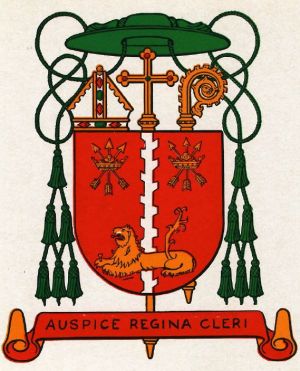Jerome Aloysius Daugherty Sebastian
JEROME ALOYSIUS DAUGHERTY SEBASTIAN
Born : November 22, 1895
Deceased : October 11, 1960
Auxiliary Bishop of Baltimore, 1953-1960; Titular Bishop of Baris
Official blazon
Gules, a pale raguly argent between six arrows in chief, three and three, points upwards, two saltirewise and one in pale, each of the sheaves surrounded by a crown or, over all in base a lion couchant of the last, the dexter paw wounded with a thorn of the second.
Motto: Auspice Regina Cleri.
Origin/meaning
This coat of arms derives its principal meaning from the legend connected with the life of St. Sebastian, one of the most renowned of the Roman martyrs. The best known symbol of St. Sebastian is the tree and the arrows.
The legend tells us that Sebastian was descended from a noble family. When still quite young, he was made a commander of a company of the Pretorian Guards, and was thus always near the Emperor Diocletian, with whom he was a special favorite. St. Sebastian was secretly a Christian, and while he fulfilled all his duties to the Emperor, he also protected Christians and endeavored to make converts. Among those whom he thus influenced were two soldiers called Marcus and Marcellinus. The tradition states that Sebastian exhorted them to die for their Faith with such earnestness that many of the guards and even the judge himself were converted and secretly baptized. Diocletian then ordered that Sebastian should be bound to a stake or a tree and shot to death with arrows. Although he was left for dead, none of the arrows had hit a vital spot, and St. Irene, the widow of one of his friends who had been martyred, came with her companions and nursed him back to health. After his recovery, St. Sebastian went to the palace to plead again for other Christians who had been condemned to death. Diocletian, surprised and infuriated, then commanded
that Sebastian be taken to the circus and beaten to death with clubs..
The "pale raguly" is the heraldic equivalent of a barren tree, inasmuch as it resembles a tree trunk bereft of its branches. At either side are placed two groups of three arrows each, this trinitarian number being chosen to indicate that St. Sebastian died for his Faith, in the name of the Father, and of the Son, and of the Holy Ghost.
The golden crowns encircling the arrows not alone represent a crown of martyrdom, but also signify St. Elizabeth of Hungary, the titular of the parish where Bishop Sebastian was pastor at the time of his appointment. The lion commemorates St. Jerome, the baptismal name Patron of the Bishop. The lion is emblematic of the boldness and watchfulness of this Saint, but there also is a tradition in connection with this symbol. One day a lion limped, as if wounded, into the retreat of St. Jerome. The monks were terrified and fled, all except the Saint who went to meet him, extracted a thorn, and tended the wound until he was well. From this time on, the lion became his constant companion.
The motto has been chosen to commemorate the years which Bishop Sebastian spent as Director of Religious Vocations under the guidance of the "Queen of the Clergy."
This page is part of the Ecclesiastical heraldry portal
|
Catholic heraldry
|
Other Christian churches |
|
Literature : Brassard, 1960

